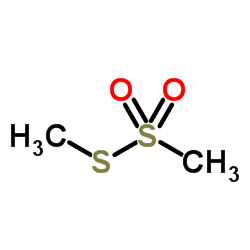Methyl Methanethiosulfonate

Methyl Methanethiosulfonate structure
|
Common Name | Methyl Methanethiosulfonate | ||
|---|---|---|---|---|
| CAS Number | 2949-92-0 | Molecular Weight | 126.198 | |
| Density | 1.3±0.1 g/cm3 | Boiling Point | 266.9±9.0 °C at 760 mmHg | |
| Molecular Formula | C2H6O2S2 | Melting Point | N/A | |
| MSDS | Chinese USA | Flash Point | 87.8±0.0 °C | |
| Symbol |

GHS07 |
Signal Word | Warning | |
|
Proteomic profile of dormancy within Staphylococcus epidermidis biofilms using iTRAQ and label-free strategies.
Appl. Microbiol. Biotechnol. 99(6) , 2751-62, (2015) Staphylococcus epidermidis is an important nosocomial bacterium among carriers of indwelling medical devices, since it has a strong ability to form biofilms. The presence of dormant bacteria within a biofilm is one of the factors that contribute to biofilm an... |
|
|
Down regulation of NO signaling in Trypanosoma cruzi upon parasite-extracellular matrix interaction: changes in protein modification by nitrosylation and nitration.
PLoS Negl. Trop. Dis. 9 , e0003683, (2015) Adhesion of the Trypanosoma cruzi trypomastigotes, the causative agent of Chagas' disease in humans, to components of the extracellular matrix (ECM) is an important step in host cell invasion. The signaling events triggered in the parasite upon binding to ECM... |
|
|
Mitochondrial proteomic analysis reveals the molecular mechanisms underlying reproductive toxicity of zearalenone in MLTC-1 cells.
Toxicology 324 , 55-67, (2014) Zearalenone (ZEA), a Fusarium mycotoxin that contaminates cereal crops worldwide, has been shown to affect the male reproductive system and trigger reactive oxygen species (ROS) generation. However, the mechanisms of its toxicity have not been fully understoo... |
|
|
Master redox regulator Trx1 upregulates SMYD1 & modulates lysine methylation.
Biochim. Biophys. Acta 1854 , 1816-22, (2015) Thioredoxin 1 (Trx1) is а antioxidant protein that regulates protein disulfide bond reduction, transnitrosylation, denitrosylation and other redox post-translational modifications. In order to better understand how Trx1 modulates downstream protective cellula... |
|
|
Flexibility of the Kir6.2 inward rectifier K(+) channel pore.
Proc. Natl. Acad. Sci. U. S. A. 98(7) , 4227-32, (2001) Interactions of sulfhydryl reagents with introduced cysteines in the pore-forming (Kir6.2) subunits of the K(ATP) channel were examined. 2-Aminoethyl methanethiosulfonate (MTSEA(+)) failed to modify Cd(2+)-insensitive control-Kir6.2 channels, but rapidly and ... |
|
|
Dramatic improvement of proteomic analysis of zebrafish liver tumor by effective protein extraction with sodium deoxycholate and heat denaturation.
Int. J. Anal. Chem. 2015 , 763969, (2015) Majority of the proteomic studies on tissue samples involve the use of gel-based approach for profiling and digestion. The laborious gel-based approach is slowly being replaced by the advancing in-solution digestion approach. However, there are still several ... |
|
|
Proteomics analysis of EV71-infected cells reveals the involvement of host protein NEDD4L in EV71 replication.
J. Proteome Res. 14(4) , 1818-30, (2015) Enterovirus 71 (EV71) is a human enterovirus that has seriously affected the Asia-Pacific area for the past two decades. EV71 infection can result in mild hand-foot-and-mouth disease and herpangina and may occasionally lead to severe neurological complication... |
|
|
Identification and characterization of a novel Geobacillus thermoglucosidasius bacteriophage, GVE3.
Arch. Virol. 160 , 2269-82, (2015) The study of extremophilic phages may reveal new phage families as well as different mechanisms of infection, propagation and lysis to those found in phages from temperate environments. We describe a novel siphovirus, GVE3, which infects the thermophile Geoba... |
|
|
Prion protein and copper cooperatively protect neurons by modulating NMDA receptor through S-nitrosylation.
Antioxid. Redox Signal. 22(9) , 772-84, (2015) Several neurodegenerative disorders show alterations in glutamatergic synapses and increased susceptibility to excitotoxicity. Mounting evidence suggests a central role for the cellular prion protein (PrP(C)) in neuroprotection. Therefore, the loss of PrP(C) ... |
|
|
Unraveling the functions of type II-prohibitins in Arabidopsis mitochondria.
Plant Mol. Biol. 88 , 249-67, (2015) In yeast and mammals, prohibitins (PHBs) are considered as structural proteins that form a scaffold-like structure for interacting with a set of proteins involved in various processes occurring in the mitochondria. The role of PHB in plant mitochondria is poo... |